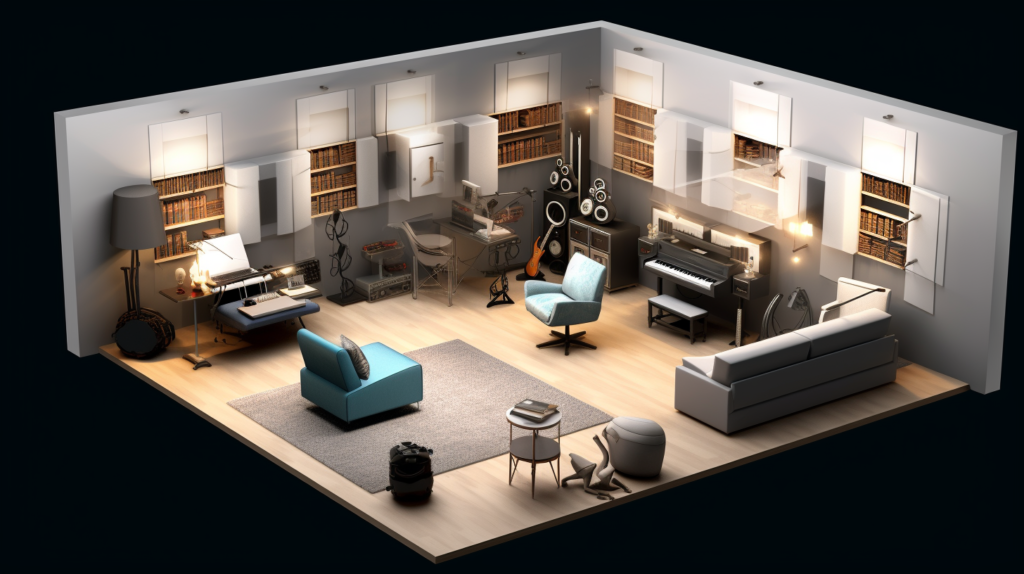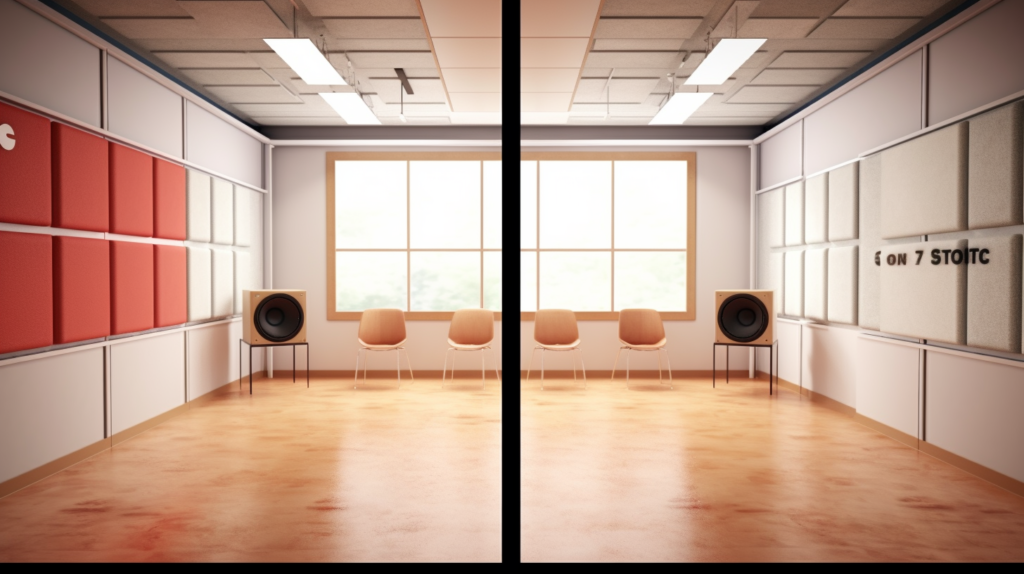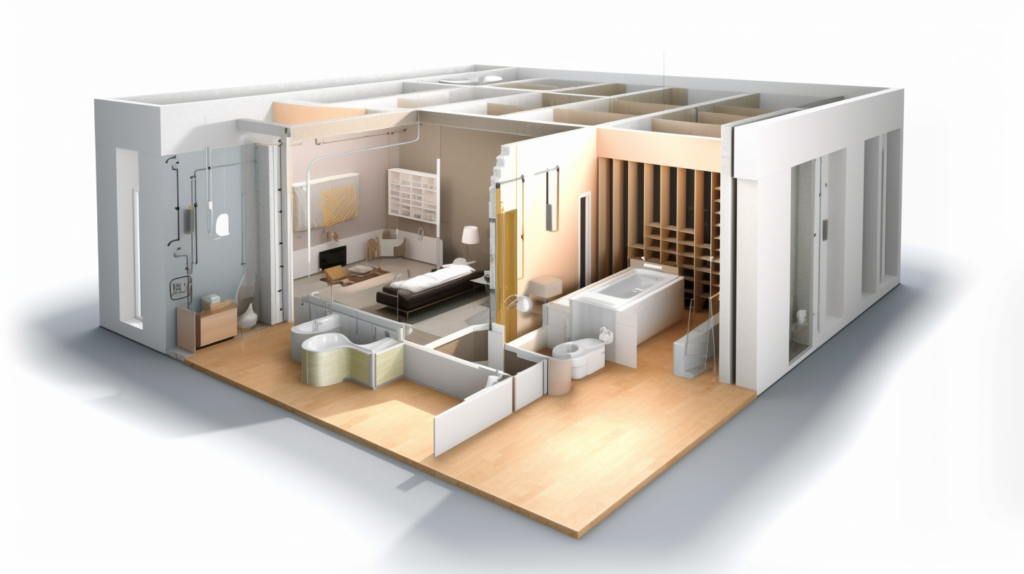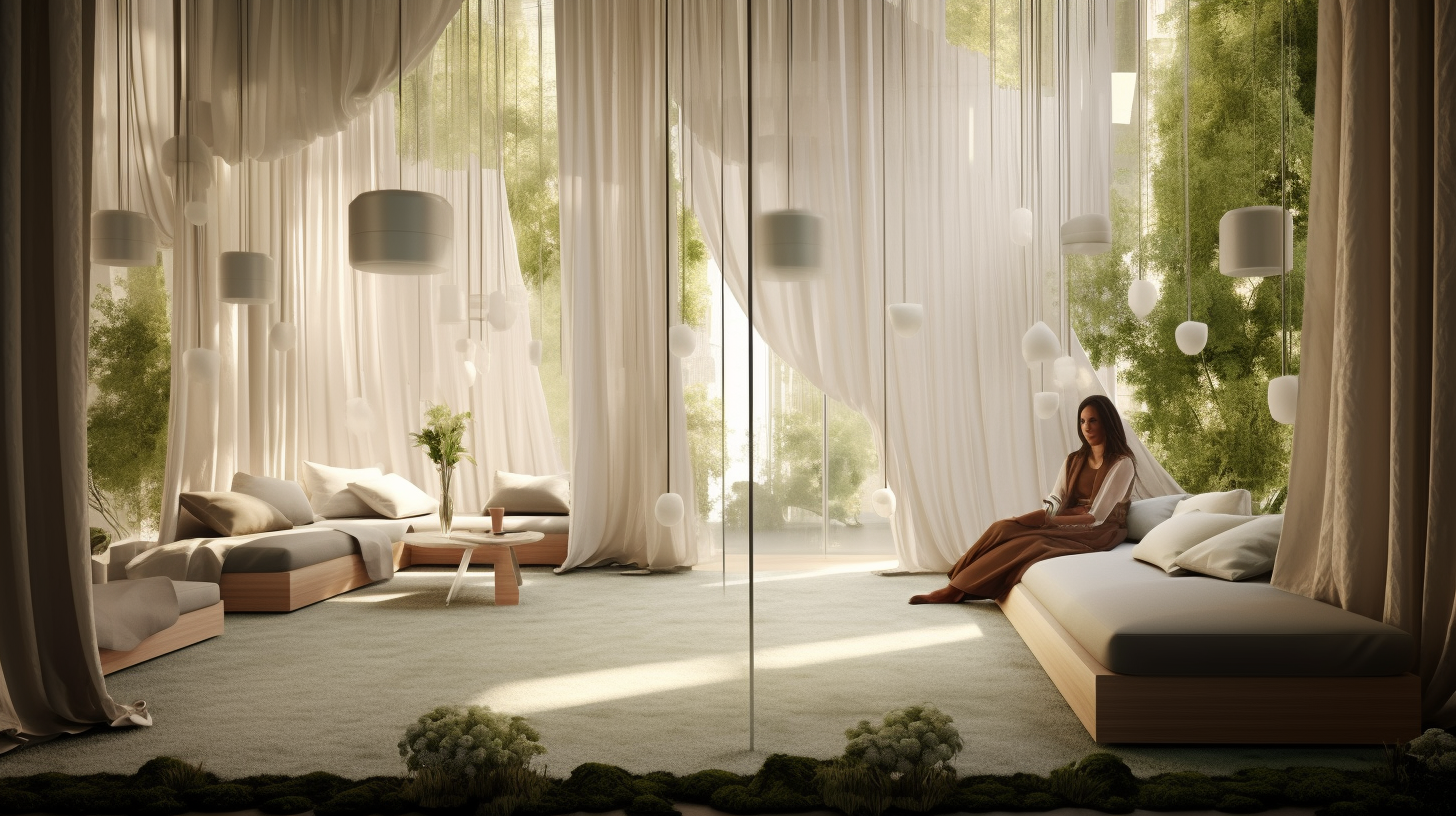Have you ever been jolted awake by a car horn at 3 a.m. or found yourself unable to focus on work because of your neighbor’s non-stop barking dog?
These disruptions make one thing clear: the importance of a quiet space.
So, how do you transform your noisy room into a sanctuary of peace?
The answer lies in effective soundproofing.
This comprehensive guide aims to demystify the complex world of soundproofing.
From understanding the difference between soundproofing and acoustic treatment to choosing the right materials and techniques, we’ve got you covered.
You’ll also learn about the crucial ratings to look for and how to soundproof different areas of a room for maximum effectiveness.
So, if you’re tired of unwanted noise ruining your peace or are just curious about what it takes to create a quieter environment, you’re in the right place.
Let’s dive into the essentials of soundproofing a room.
What is Soundproofing Anyway?

One of the most common misconceptions people have is conflating soundproofing with acoustic treatment.
While both are related to the science of sound, they serve distinct functions.
Soundproofing is all about isolation—it’s the art and science of keeping sound from entering or leaving a particular space.
Whether you’re trying to keep noisy neighbors at bay or preventing your music from disturbing others, soundproofing provides the barrier you need.
Acoustic treatment, on the other hand, doesn’t prevent sound from entering or leaving a space. Instead, it enhances the audio environment within a specific area.
Musicians, podcasters, and home theater enthusiasts often use acoustic treatment to improve the quality of sound in a room.
Acoustic treatment can control or eliminate issues like echo, reverb, and audio distortion, creating a cleaner, more precise sound environment.
The materials used in soundproofing are often dense and heavy to block out sound effectively.
They work by adding mass to walls, floors, and ceilings, thereby reducing the ability of sound to pass through. Acoustic treatment materials, by contrast, are usually lighter and more porous.
They work by absorbing sound waves, preventing echo and reverberation within a confined space.
How Does Soundproofing Differ From Acoustic Treatment?

The distinctions between soundproofing and acoustic treatment aren’t merely academic; they have real-world applications that can significantly impact your quality of life.
If you live next to a busy road, your primary concern is likely to be reducing the amount of traffic noise that invades your living space.
In this case, soundproofing solutions would be your go-to option.
On the other hand, if you have a home theater or a recording studio, your focus might be on enhancing the audio experience within that room.
Here, acoustic treatment solutions would be more appropriate.
Understanding the unique benefits and limitations of each approach is crucial.
For example, soundproofing materials are excellent at reducing noise levels but may not do much to improve the quality of sound within a room.
Conversely, acoustic treatment can make your music or podcast sound better but won’t keep out the sounds of lawn mowers, traffic, or noisy neighbors.
In some situations, a combination of both soundproofing and acoustic treatment may be necessary.
For example, if you’re setting up a home recording studio, you’ll want to prevent external noises from contaminating your recordings (soundproofing) and improve the acoustic quality of the sound being recorded (acoustic treatment).
Being clear about your goals can help you decide which approach is best for your specific needs.
What Ratings Should You Look At For Soundproofing? (Hint: NOT SAC and NRC)

When it comes to soundproofing, not all materials are created equal, and the effectiveness of different solutions can vary significantly.
To make an informed decision, it’s crucial to understand the various ratings that indicate a material’s soundproofing capabilities.
The most important of these is the Sound Transmission Class (STC). This numerical rating measures a material’s ability to reduce airborne sound.
In other words, a higher STC rating means that the material is better at blocking out noises such as conversations, TV sound, and music.
While STC is vital for soundproofing, you might also come across other metrics like Sound Absorption Coefficient (SAC) and Noise Reduction Coefficient (NRC).
These ratings are less relevant for soundproofing but are highly important in the realm of acoustic treatment. SAC measures how much sound a particular material absorbs, represented as a number between 0 and 1, with 1 indicating total absorption.
NRC, on the other hand, is a measurement that averages the absorption coefficients at various frequencies, also providing a value between 0 and 1.
To sum it up, if you’re looking to block or isolate sound, focus on the STC ratings of materials.
If your goal is to improve the sound quality within a specific space, SAC and NRC ratings will be more pertinent.
Knowing which rating to consider for your project can save you time, money, and potential disappointment down the line.
What is the Legal STC Rating Requirement for Apartments?

If you’re apartment hunting with soundproofing in mind, you’ll want to pay close attention to the Sound Transmission Class (STC) ratings of different properties.
In most jurisdictions, building codes specify a minimum STC rating to enhance the living conditions for residents.
While the exact requirements can vary, an STC rating of 55 is generally considered the minimum acceptable standard for walls in multi-family residences.
This rating offers a reasonable level of soundproofing, effectively blocking out casual conversations and ambient noise.
However, it’s essential to keep in mind that while an STC rating of 55 might be adequate for some people, it may not suffice for those particularly sensitive to noise or those who require very quiet conditions.
When looking for an apartment, inquire about the STC ratings of not just the walls but also the floors, ceilings, windows, and doors.
These additional factors can significantly impact your living experience, especially if you are sensitive to noise.
If the property management can’t provide this information, it could be a sign that soundproofing wasn’t a priority in the building’s construction, and you might want to consider other options.
What Types of Noise Should You Be Concerned About?

Understanding the types of noise you’re dealing with is crucial for planning an effective soundproofing strategy.
Essentially, noises can be categorized into two types: airborne and structure-borne.
Airborne noise is the sound that travels through the air from sources like people talking, music playing, or cars driving by.
These are the sounds that you can hear directly, and they often come through gaps in doors, windows, or even walls if they are not adequately soundproofed.
Structure-borne noise, on the other hand, is a bit more insidious. This type of noise originates from vibrations that travel through a building’s structure.
Examples include the sound of footsteps from an upstairs neighbor, the rumble of a washing machine, or even the vibrations from construction work.
These sounds are often harder to isolate and require a different set of soundproofing strategies.
Airborne noise can often be managed with relatively straightforward solutions like adding mass to your walls or installing soundproof curtains.
Structure-borne noise might require more complex solutions like decoupling techniques that involve separating the interior and exterior layers of a wall or floor to prevent sound transmission.
The methods you’ll need to employ will depend on the type of noise you’re trying to mitigate, so it’s essential to diagnose your noise problems accurately before diving into potential solutions.
How To Soundproof A Room

Soundproofing is not a one-dimensional task that stops with the walls.
To effectively block out noise, a holistic approach that considers multiple surfaces—windows, doors, ceilings, and floors—is necessary.
Each surface presents unique challenges and requires tailored solutions. Below, we briefly explore the nuances of soundproofing these different areas.
How To Soundproof Your Windows: More Than Just Glass
Windows are often the weakest links when it comes to soundproofing. They can let in a wide range of noises, from traffic to chatter.
The first step in window soundproofing is often to consider double or triple glazing, which can significantly reduce the amount of noise entering your space.
For more details, check out our detailed guide on window soundproofing.
How To Soundproof Your Doors
You might not think it, but doors can be a significant source of sound leakage. Many homes feature hollow-core doors that offer little sound insulation.
Replacing these with solid-core doors and adding weatherstripping can make a significant difference.
For a more in-depth look at soundproofing doors, consult our comprehensive article here.
How To Soundproof Your Ceiling
Ceilings can be problematic, particularly if you have noisy upstairs neighbors.
Adding an extra layer of drywall can provide a degree of soundproofing, but for more severe problems, more advanced techniques like creating a “floating” ceiling may be necessary.
For more information, read our full guide on ceiling soundproofing.
How To Soundproof Your Floors
Last but not least, floors can transmit a lot of structure-borne noise, especially in multi-story buildings.
Soundproofing mats can offer a quick fix, but for more comprehensive solutions, you may need to consider building a floating floor. Learn more in our detailed article on floor soundproofing.
What Materials Are Most Effective for Soundproofing?

The world of soundproofing materials is vast, and choosing the right one for your project can be a daunting task.
However, the effectiveness of your soundproofing effort hinges significantly on the materials you choose.
When it comes to blocking sound, denser materials like mineral wool, fiberglass wool, and rubber are usually the most effective.
These materials work by adding mass, which in turn reduces the ability of sound to pass through walls, floors, and ceilings.
Mineral wool and fiberglass wool are often used in the form of batts that can be inserted into wall cavities or placed between floor joists.
These materials are particularly effective because they not only block sound but also have thermal insulating properties, serving a dual purpose.
Rubber, often in the form of mass-loaded vinyl, is another excellent material for soundproofing.
It can be used in a variety of applications, from lining walls and ceilings to laying it under flooring.
While acoustic panels and foam are popular materials, they are generally not suitable for soundproofing applications.
These materials are designed to treat the sound within a room, not to prevent sound from entering or leaving it.
They are porous and lightweight, which makes them excellent for absorbing sound waves and reducing echoes, but poor at blocking sound transmission.
Therefore, if your primary aim is to create a sound barrier, it’s best to stick with denser, more substantial materials like mineral wool, fiberglass wool, or rubber.
Conclusion
You’ve journeyed through the intricate world of soundproofing, a subject that might have seemed intimidating at the outset.
Now, armed with a newfound understanding, you’re better positioned than ever to tackle your soundproofing challenges head-on.
You’ve learned the crucial differences between soundproofing and acoustic treatment, the types of noise that can disrupt your peace, and the materials that can effectively block them.
You’ve also gained insights into the ratings and standards that guide the world of soundproofing, offering you a benchmark for your endeavors.
As you embark on your project, remember that knowledge is only the first step.
The next phase involves thoughtful planning, selecting the right materials, and perhaps even consulting with professionals to ensure that your soundproofing efforts meet your specific needs.
Whether you aim to block out the noisy cityscape, create a serene workspace, or build a home studio, the knowledge you’ve gained here is your first step toward a quieter, more peaceful environment.
Soundproofing isn’t just a project; it’s an investment in your well-being. So don’t delay. Take the first step today, and reclaim the tranquility you deserve.
